Warmth No Deterrent to Bike To Work Day
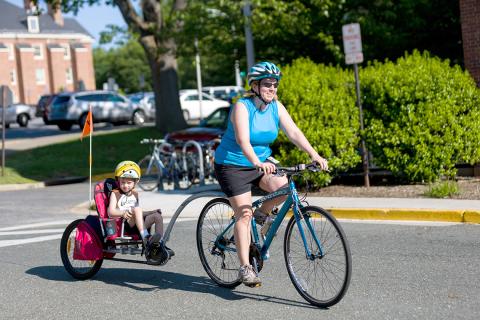
Photo: Daniel Soñé
This year’s Bike to Work Day was “one of the warmest, but certainly not the rainiest,” said NIGMS’s Dr. Vernon Anderson, president of the NIH Bicycle Commuter Club (NIHBCC). But the heat didn’t deter NIH’s bicycle commuters from passing through three NIH-affiliated “pit stops.”
According to the Metropolitan Washington Council of Governments, which sponsors BTWD in the national capital region, NIH had 537 participants registered for the May 19 event. An additional 70 NIH bicyclists registered at the Bldg. 1 pit stop, bringing total NIH BTWD participation to 607.
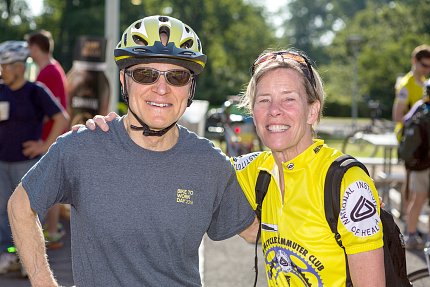
Photo: Daniel Soñé
At the Bldg. 1 site, 346 riders stopped to grab breakfast and a T-shirt or get their bike tuned up. NCI had 49 participants, the most of any IC. NIHBCC and ORS’s Division of Amenities and Transportation Services organized the annual event.
The other two NIH-affiliated BTWD pit stops were Rockledge Dr. at Rock Springs Business Park and Fallsgrove Village Center, near NCI-Shady Grove in Rockville.
Diane Baker gave brief remarks at the Bldg. 1 event. She spoke on behalf of her husband, NIH director Dr. Francis Collins, who couldn’t attend. They are both avid cyclists themselves.
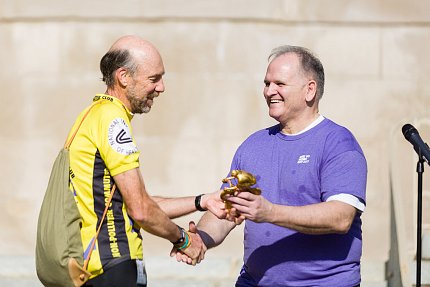
Photo: Daniel Soñé
“Bike to Work Day is something Francis and I really enjoy,” she said. “It’s not always easy, but it is always fun. And I just want you to hear from both of us how much we support this kind of activity.”
After Baker spoke, Joe Cox, ORS’s chief of transportation services, presented the sixth annual Carl Henn Award to Dr. Bill DeGraff, a retired scientist in the Radiation Biology Branch at NCI. Henn, who passed away in 2010, was a co-founder and president of the NIHBCC and a dedicated environmentalist. The award is given to someone who exemplifies his values.
“Bill was one of the original pillars of the NIH bike club,” said Cox. “He was treasurer for years and he was at every meeting I ever went to with the bike club. He’s a nice guy. I really enjoyed being around him. He’s quiet and not a very outspoken enthusiast, but he was always there to show you his passion.”
Although he’s been retired for almost a year and a half, DeGraff still enjoys coming back on campus to help out with Bike to Work Day and catching up with his former colleagues.
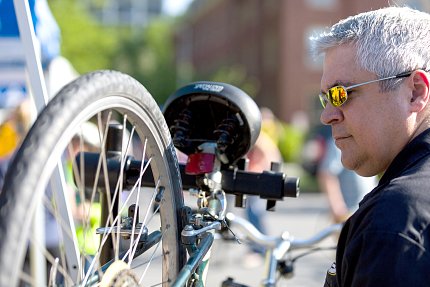
Photo: Daniel Soñé
“It’s nice to be recognized for the things you do and I stand in very good company” with previous Henn award winners, he said. “I really appreciate this.”
For those interested in pedaling to work, NHGRI’s Peter Chines suggests a visit to the NIHBCC web site at http://www.nihbike.com/. There, users will find resources they need to saddle up. They can also join a listserv or look up the contact information for ride mentors, volunteers familiar with myriad commutes between neighborhoods and NIH. “We’re excited to help new bike commuters,” Chines said.
NLM’s Dominic Napoli rode his e-bike into work. The bike features a battery-powered electric motor. When the motor turns on, he explained, it’s like “someone getting behind and pushing you.” E-bike riders don’t have to pedal as hard up hills and they don’t slow down when they coast.
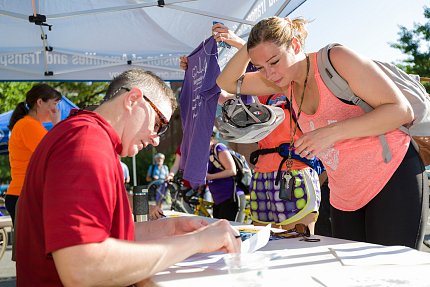
Photo: Daniel Soñé
This year, the longest commute of the day belonged to NINDS’s Jim Nagle. He rode in from Reston, Va., and his round trip was 47 miles. The total combined round trips of those who commuted to the Bldg. 1 pit stop was 4,000 miles.
For Cox, advocating for bikers on campus is a “no-brainer.” He noted, for example, that 15 bikes can fit in two parking spaces. There are plenty of bike racks and lockers around campus. Biking to work also has environmental and health benefits.
And there’s another benefit for those who aren’t morning people: “You don’t need a parking spot, so you can come in anytime you want,” Cox said.
